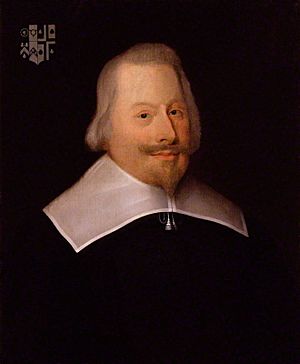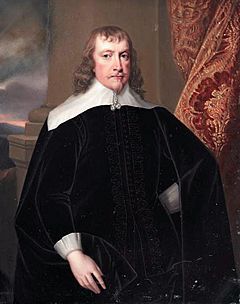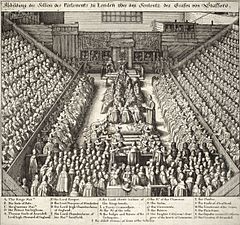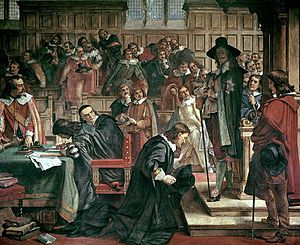John Pym facts for kids
Quick facts for kids
John Pym
|
|
|---|---|
 |
|
| Committee of Safety | |
| In office July 1642 – December 1643 |
|
| Monarch | Charles I |
| Member of Parliament for Tavistock |
|
| In office November 1640 – December 1643 † |
|
| Member of Parliament for Calne |
|
| In office 1621–1622 |
|
| Receiver-General Exchequer, Glos., Hants and Wilts. | |
| In office 1606–1639 |
|
| Personal details | |
| Born | 20 May 1584 London |
| Died | 8 December 1643 (aged 59) London |
| Cause of death | Cancer |
| Resting place | Westminster Abbey (initially); St Margaret's (now) |
| Nationality | English |
| Spouse | Anne Hooker or Hooke (1604–1620) |
| Children | 7, including Charles |
| Parents | Alexander Pym (1547–1585) Philippa Colles |
| Relatives | Francis Rous (stepbrother) Anthony Nicholl (nephew) |
| Alma mater | Pembroke College, Oxford |
| Occupation | Lawyer, politician and businessman |
John Pym (born May 20, 1584 – died December 8, 1643) was an important politician and administrator from London, England. Many people see him as one of the key figures who helped create Parliamentary democracy in England. He was one of the Five Members whose attempted arrest by King Charles I in January 1642 helped start the First English Civil War.
Pym was very skilled at using Parliament's rules to outsmart his opponents. People at the time respected him greatly for his abilities. A historian named Goldwin Smith even called him "the greatest member of Parliament that ever lived" in 1895.
His father died when John was very young. He was raised by his stepfather, Sir Anthony Rous. From his stepfather, Pym learned strong Puritan beliefs. He also developed a deep dislike for the religious changes made by Archbishop William Laud. Pym was also a key member of the Providence Island Company. This company tried to set up a Puritan colony in Central America.
He was known as a "true revolutionary." Pym led the fight against kings who tried to rule without Parliament. This included both King James I and later King Charles I. His leadership was vital for the Parliamentarian side in the early part of the war. He played a big role in getting the Scots to support Parliament through the Solemn League and Covenant. His death from cancer in December 1643 was a major loss for his side.
Pym was first buried in Westminster Abbey. But after the king returned to power in 1660, his body was moved. It was placed in a common pit at nearby St Margaret's, Westminster with other Parliamentarian leaders. Today, he is seen as a smart politician and a powerful speaker. His ideas influenced American Patriots during the American Revolution. They also inspired 19th-century American liberals.
Contents
About John Pym's Life
John Pym's father, Alexander Pym (1547–1585), was a lawyer from Somerset. John was born in London in 1584. His father died just seven months later. His mother, Philippa Colles (died 1620), then married Sir Anthony Rous. Sir Anthony was a rich landowner from Cornwall.
Sir Anthony was a close friend of Sir Francis Drake. He taught John to dislike Spain and to strongly believe in Puritanism. He also taught him to oppose the Catholic Church and other Protestant ideas.
The Rous family was large and close. They often married relatives or friends. In May 1604, Pym married Anne Hooke. She was the aunt of the famous scientist Robert Hooke. Before Anne died in 1620, they had seven children. Four of them lived to be adults: Philippa (1604–1654), Charles (1615–1671), Dorothy (1617–1661), and Catherine.
Pym's Political Journey
Pym studied at Pembroke College, Oxford. This college was known for its "advanced Protestantism." He later attended the Middle Temple in 1602 to learn about law. He made many lifelong friends there, especially William Whitaker.
In June 1605, Pym became a tax collector for the Exchequer. He worked in Hampshire, Gloucestershire, and Wiltshire. This job helped him meet many different people. In 1621, he was elected as a Member of Parliament for Calne.
Fighting for Rights in Parliament
Pym kept a diary that showed he looked at all laws together, not just his own interests. He was good at explaining complex ideas clearly. This led to him being chosen for many important committees.
At that time, directly criticizing the king was seen as treason. So, people expressed their opposition by attacking the king's advisors. They used a process called impeachment. Pym argued that the Commons should decide if someone was guilty. The Lords would then decide the punishment. This idea became very important later in his career.

Pym was strongly against Catholicism. He also opposed what he saw as Catholic practices in the Church of England. In the 1600s, religion and politics were closely linked. Changes in one often meant changes in the other. Many people were worried that King James I was not helping his Protestant relatives in Europe. This was during the Thirty Years War.
After Parliament was closed in 1621, Pym was arrested. He was brought before the Privy Council but was released in August 1622. In 1624, he was elected for Tavistock. This seat was controlled by the Earl of Bedford. Pym kept this seat for the rest of his career.
He was a main leader in trying to impeach the Duke of Buckingham in 1626. This action caused Parliament to be closed again. Buckingham's death in August 1628 stopped a second impeachment attempt. Pym also supported the Petition of Right presented to Charles I in 1628.
Pym, his stepbrother Francis Rous, and John Hampden also led the attack on two clergymen. These clergymen supported the idea that kings had a "divine right" to rule. They also said people should always obey the king. Parliament criticized them, but King Charles pardoned them. He then closed Parliament. This started a period called the Personal Rule, which lasted until 1640.
Pym became the treasurer of the Providence Island Company in 1630. This job took up more and more of his time. He left his tax collector position in 1639. Many Puritan leaders were involved in colonial movements. Company meetings also became a secret way for them to plan political opposition. Many of these people later became leaders against the king in 1642. These included Hampden, Rous, and others.
Leading the Opposition: 1640 to 1641

After losing the first Bishops Wars, King Charles called Parliament back in April 1640. This was called the Short Parliament. It refused to approve new taxes unless the king made changes. So, Charles closed it after only three weeks. But the Scots defeated him again. The harsh terms of the Treaty of Ripon forced him to call new elections in November. Pym became the unofficial leader of the opposition.
Many historians believe that by 1640, most people agreed the king had gone too far in ruling without Parliament. But this changed after the Grand Remonstrance in November 1641. Some people, like Clarendon, who believed in a king with limited power, then sided with the king. They felt Parliament was now asking for too much.
Pym understood that King Charles would not keep his promises. Even while talking with moderate members of Parliament, Charles and Queen Henrietta Maria told foreign ambassadors that any agreements were temporary. They planned to take back power by force if needed. These suspicions grew in October 1641. Irish Catholic rebels claimed the king approved their actions. This seemed believable because Charles had tried to use Irish troops against the Scots before. He also refused to condemn the rebellion at first.
However, Pym faced a challenge. The king was seen as essential for a stable government and society. In 1642, most people believed a "well-ordered" monarchy was God's will. They disagreed on what "well-ordered" meant. They also disagreed on who had final authority in church matters. Royalists generally supported a Church of England led by bishops. These bishops were appointed by and answered to the king. Parliamentarians believed the king should answer to church leaders chosen by their congregations.
"Puritan" was a term for anyone who wanted to "purify" the Church of England. There were many different groups of Puritans. Presbyterians were the most common. Leaders like Pym and John Hampden were Presbyterians. But there were other groups, like Congregationalists, often called Independents.
Religion and politics were closely connected. One reason for opposing bishops was their presence in the House of Lords. They often blocked laws passed by Parliament. Their removal by the Clergy Act 1640 was a big step towards war. Most Presbyterians were politically conservative. They believed in a limited number of voters. They wanted to keep the Church of England, but as a reformed, Presbyterian church, like the Church of Scotland. England in 1640 was a structured, peaceful society. Many people wanted to avoid war at all costs, seeing the devastation of the Thirty Years War in Europe.
The Path to War: 1641 to 1643
Soon after the Long Parliament met, it received the Root and Branch petition. This petition, signed by 15,000 Londoners, demanded that England remove bishops, like the Scots had done. This showed widespread worry about "Catholic practices" in the church. These worries grew because Charles seemed willing to fight Protestant Scots but not help his nephew regain his lands. Many feared Charles would ally with Spain.

Ending Charles's rule without Parliament was important for England and for Protestants in general. People respected the idea of monarchy, so they could not directly attack Charles. Instead, they prosecuted his "evil counsellors." This showed that while the king was above the law, his helpers were not. It also meant the king could not protect them. This was meant to make others think twice about their actions. Archbishop William Laud was accused in December 1640 and held in the Tower of London until his execution in 1645. Strafford, a former leader in Ireland, was executed in May 1641.
The Commons also passed new laws to reform the government. These included the Triennial Acts, which made Parliament meet regularly. They also abolished the Star Chamber and ended taxes without Parliament's approval. The bishops in the House of Lords voted together and rejected all these laws. In June 1641, Pym helped pass the Clergy Act in the Commons. A key part of this law was to remove bishops from the Lords. So, the Lords rejected it.
Political tension grew. In October, the Irish Rebellion broke out. Both Charles and Parliament wanted to raise troops to stop it. But neither trusted the other with control of the army. They feared the army would be used against them first.
Pym helped write the Grand Remonstrance. This document was given to Charles on December 1, 1641. Unrest grew, leading to riots in Westminster from December 23 to 29. These riots were led by London apprentices. It is not proven that Pym helped organize these riots. But because of them, bishops stopped attending the Lords. On December 30, John Williams, the Archbishop of York, and eleven other bishops signed a complaint. They said any laws passed by the Lords while they were excluded were not legal. The Commons saw this as inviting Charles to close Parliament. All twelve bishops were then imprisoned for treason.
Because of the growing unrest, Charles tried to arrest the Five Members on January 4. Pym was one of them. Charles failed to arrest them. He then left London with many Royalist Members of Parliament and his supporters in the Lords. This was a big mistake. It gave the opposition majorities in both houses.
When the First English Civil War began in August, Pym led the Committee of Safety. His honesty and ability to keep different groups working together were very important. This helped Parliament survive the first 18 months of the war.
By early August 1643, the Royalists had won several battles. Also, the popular John Hampden had died in June. It seemed like the Parliamentarian side was about to lose. At this critical moment, Pym's leadership and determination saved them. He helped Parliament get enough money and soldiers. One of his last actions was to arrange the Solemn League and Covenant. This agreement secured Scottish support for Parliament.
John Pym died, probably from cancer, on December 8, 1643. Parliament agreed to pay off his debts. He had neglected his own business interests while serving the public. He was buried in Westminster Abbey. But after the king returned to power in 1660, his body was removed. It was re-buried in a common pit at St Margaret's, Westminster.
His main opponent, the Earl of Clarendon, later wrote that Pym "had a very comely and grave way of expressing himself...and understood the temper and affections of the kingdom as well as any man." Pym's reputation was sometimes overshadowed by figures like Hampden. But today, he is seen as a smart politician who helped create modern Parliamentary democracy. His ideas influenced American revolutionaries and 19th-century American liberals.
See also
 In Spanish: John Pym para niños
In Spanish: John Pym para niños


